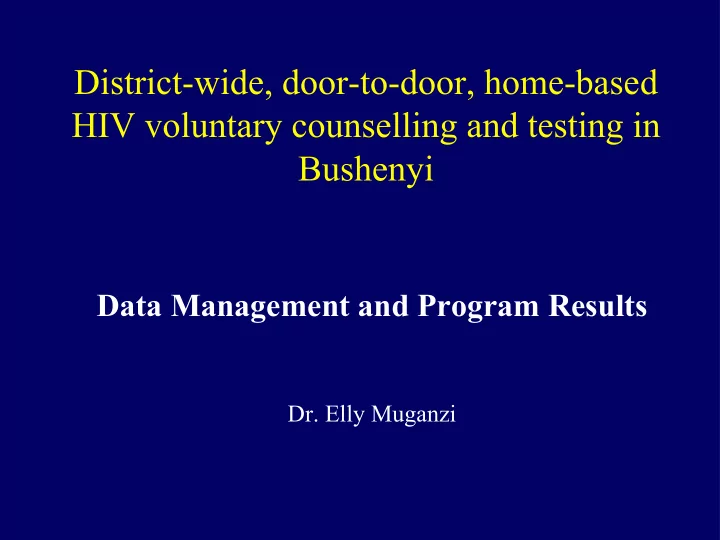

District-wide, door-to-door, home-based HIV voluntary counselling and testing in Bushenyi ����������������������������������� Dr. Elly Muganzi
Objectives of data management • General To generate information that can be used to improve program activities & also document lessons learnt • Specific – Generate monthly and quarterly reports – Identify and monitor key indicators necessary for program evaluation and improvement. – Document and disseminate good practices – Maintain a data bank for future reference
Data management methods • Data collected by lab assistants, counsellors, and RPMs using standardised forms. • Double data entry done using Epi Info • Analysis done using SPSS • Analysis covers Jan 2005 to March 2006 • 137,023 clients are included in this analysis
Results • From January 2005 to March 2006, 153,096 people in 46,525 households were identified as eligible for HIV-CT • 137,023 (89.5%) were present at home and accepted pre-test counselling • 136,865 (99.9%) accepted testing, received results, 91% of these had never tested for HIV and 82% of the repeat testers were HIV negative
Results No.identified eligible for 153,059 HIVCT No. present at home 137,023(89.5%) &accepted pre-TC No. accepted testing and 136,865(99.9%) received results No never tested before 124,953(91.3%) Previous testers negative 9608(82.4%)
Results • HIV CT coverage (Proportion tested divided by proportion eligible in HH- both present & absent) was 89% (85% male, 94% female). • Overall, 7,058 (5.2%) were HIV-infected (women: 6.2%, men 4.0%, �� ≤0.001). • 6,028 (85%) of these HIV positive people had not tested for HIV before.
UPTAKE ��������������������������� ������������������������� ������� #��������������$�$ ��������� ��!� ����"� �������" %������ " &''������()*�����!�����+"� ������ " ��,����� �������"� %��������"
HIV Prevalence by Age ����� %������ *����� .-������ &��������� ������ ���-����'�� %������� ���-����'�� *����� ������-�� ���-����'�� 0-4 years 422 9.0 487 7.0 911 72 7.9 5-9 years 741 5.8 804 4.7 1547 81 5.2 10-14 years 3330 1.2 3679 1.0 7025 75 1.1 15-19 years 11296 0.4 11716 1.8 23046 256 1.1 20-24 years 11044 1.8 12094 5.4 23152 849 3.7 25-29 years 8838 4.3 10277 9.0 19130 1299 6.8 30-34 years 7227 6.8 8292 10.5 15533 1359 8.7 35-39 years 5724 7.7 6474 10.6 12205 1129 9.3 40-44 years 4422 9.0 5311 9.4 9737 895 9.2 45-49 years 3322 7.6 3651 6.5 6974 488 7.0 50-54 years 2557 5.5 3201 4.2 5759 275 4.8 55-59 years 1756 3.2 1535 2.6 3292 97 2.9 60-64 years 1749 2.5 1616 2.0 3365 77 2.3 65-69 years 1298 2.3 856 2.1 2154 48 2.2 70-74 years 904 1.4 629 1.7 1533 24 1.6 75-79 years 460 2.0 230 3.5 690 17 2.5 80+ years 459 1.3 253 1.6 712 10 1.4 N.A/Missing 30 - 38 - 100 - - *����� 65579 4.0 71143 6.2 136865 7058 5.2
/0(����-����'���1������� 7.0 6.5 6.0 5.5 5.0 4.5 ���-����'� 4.0 3.5 3.0 2.5 2.0 1.5 1.0 0.5 0.0 Male Female Sex
/0(����-����'���1������ 8.5 8.0 7.5 7.0 6.5 6.0 5.5 HIV Prevalence 5.0 Male 4.5 Female 4.0 Overall 3.5 3.0 2.5 2.0 1.5 1.0 0.5 0.0 Jan- Feb- Mar- Apr- May- Jun- Jul- Aug- Sep- Oct- Nov- Dec- Jan- Feb- Mar- 05 05 05 05 05 05 05 05 05 05 05 05 06 06 06 Months
HIV prevalence by marital status Status Tested HIV+ % Married/ 77089 3727 4.8 cohabiting Divorced/ 5906 938 15.9 Separated Widowed 7311 1337 18.3 Single 43523 969 2.2 Not stated 3036 87 2.9 Total 136,865 7058 5.2
HIV prevalence by highest level of education Highest education Tested HIV+ % None 22537 1388 6.2 Lower Primary 1-4 30953 1743 5.6 Upper Primary 5-7 57499 2894 5.0 Secondary 22041 873 4.0 Post Secondary 2664 98 3.7 Others 1171 62 5.3 Total 136,865 7058 5.2
HIV prevalence by occupation Occupation Tested HIV+ % None 7323 429 5.9 Paid employee 6231 371 6.0 Peasant 60190 3531 5.9 Casual Laborer 13303 895 6.7 Housewife 23407 1319 5.6 Vendor 750 61 8.1 Student 23724 254 1.1 Business man/woman 244 26 10.7 Others 1693 172 10.2 Total 136,865 7058 5.2
/ 0(����-����'� 10 11 12 13 14 15 16 17 18 19 20 21 0 1 2 3 4 5 6 7 8 9 Bihanga Bitereko Bugongi Bum baire Burere Ishaka Bushenyi Itendero Kabwohe Kabira /0(����-����'���1����'����1 Kagango Kakanju Kanyabwanga Karungu Kashenshero 2��'����1 Katerera Katunguru Kicwam ba Kigaram a Kitagata Kiyanga Kyabugim bi Kyam uhunga %�������'�������1 Kyangyenyi Kyeizooba Mitoom a Mutara Nyabubare Rwengwe Ryeru Shuuku
Results cont’d • Members of 13,855 married/cohabiting couples were counselled and tested together. For 95% of these couples, both partners were HIV negative, while for 2%, both partners were HIV positive. 3% of cohabiting couples are discordant. • Of all HIV positive cohabiting/married persons (674 couples, 5% of all couples tested together), 372 (55%) live in HIV discordant partnerships
Conclusions • The proportion ever having received an HIV test increased rapidly from 10% to 89% -covered areas • Home-based HIV CT is feasible in this setting, has high uptake and supports linkage to care. • Overwhelming majority of individuals who are HIV infected had not been tested before and did not know their HIV status • There are more cohabiting/married partners who are discordant for HIV than there are cohabiting / married partners who are both infected thereby highlighting the unmet HIV prevention need
THANK YOU
Recommend
More recommend